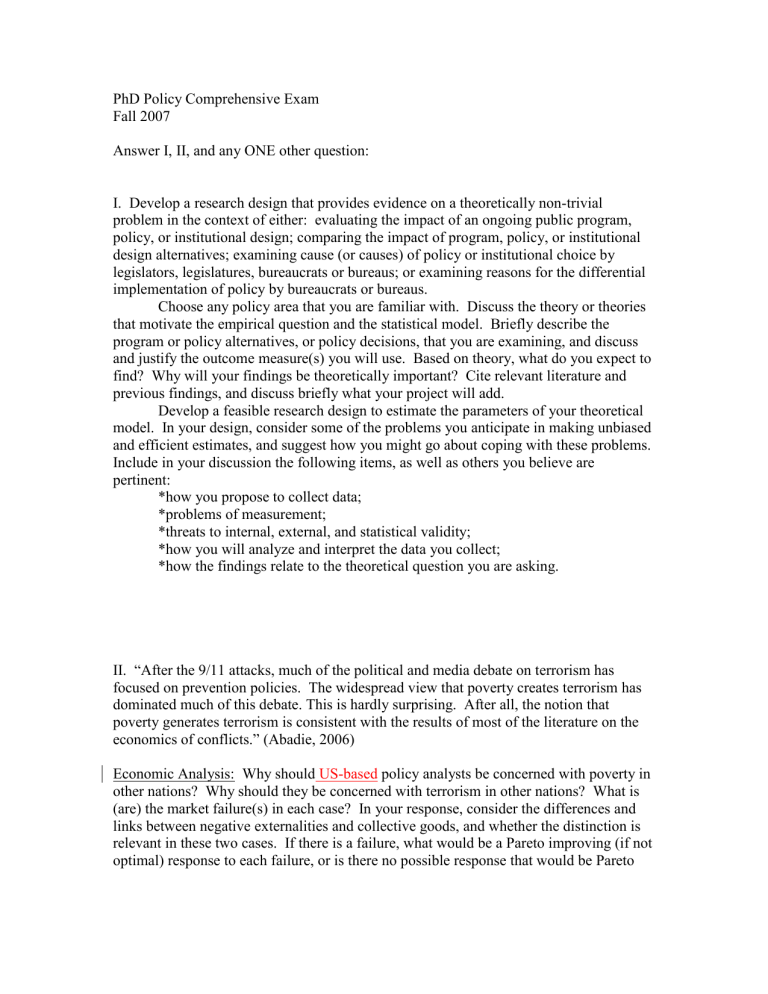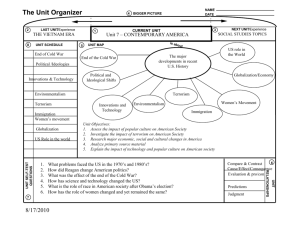PhD Policy Comprehensive Exam Fall 2007

PhD Policy Comprehensive Exam
Fall 2007
Answer I, II, and any ONE other question:
I. Develop a research design that provides evidence on a theoretically non-trivial problem in the context of either: evaluating the impact of an ongoing public program, policy, or institutional design; comparing the impact of program, policy, or institutional design alternatives; examining cause (or causes) of policy or institutional choice by legislators, legislatures, bureaucrats or bureaus; or examining reasons for the differential implementation of policy by bureaucrats or bureaus.
Choose any policy area that you are familiar with. Discuss the theory or theories that motivate the empirical question and the statistical model. Briefly describe the program or policy alternatives, or policy decisions, that you are examining, and discuss and justify the outcome measure(s) you will use. Based on theory, what do you expect to find? Why will your findings be theoretically important? Cite relevant literature and previous findings, and discuss briefly what your project will add.
Develop a feasible research design to estimate the parameters of your theoretical model. In your design, consider some of the problems you anticipate in making unbiased and efficient estimates, and suggest how you might go about coping with these problems.
Include in your discussion the following items, as well as others you believe are pertinent:
*how you propose to collect data;
*problems of measurement;
*threats to internal, external, and statistical validity;
*how you will analyze and interpret the data you collect;
*how the findings relate to the theoretical question you are asking.
II. “After the 9/11 attacks, much of the political and media debate on terrorism has focused on prevention policies. The widespread view that poverty creates terrorism has dominated much of this debate. This is hardly surprising. After all, the notion that poverty generates terrorism is consistent with the results of most of the literature on the economics of conflicts.” (Abadie, 2006)
Economic Analysis: Why should US-based policy analysts be concerned with poverty in other nations? Why should they be concerned with terrorism in other nations? What is
(are) the market failure(s) in each case? In your response, consider the differences and links between negative externalities and collective goods, and whether the distinction is relevant in these two cases. If there is a failure, what would be a Pareto improving (if not optimal) response to each failure, or is there no possible response that would be Pareto
improving? What, if any, would be a politically feasible response (in a democracy) that might be also be Pareto improving?
Econometric Analysis: Whether poverty creates terrorism is fundamentally an empirical question. Abadie (2006) tested the hypothesis using data from a cross-section of some
150 nations.
Without going into detail on the specifics of the measurement of the main concepts, the list below briefly describes the variables that Abadie used. The table presents OLS results from two models . (For purposes of this exercise, your response should focus on results, not measurement, unless there is a blatant problem of measurement.)
Focusing on the results from both models, what do the results say about the connection between poverty and terrorism? What do the results say about the other variables? Do you believe the results? (Focus on the parameter estimates and hypothesis tests for the main theoretical variables, including poverty and governance.) How, if at all, would you improve the design and/or method of analysis?
How do the results, if they are credible, affect your response to the policy question above?
The variables
Dependent variable:
World Market Research Center (WMRC) Global Terrorism Index (assesses risk of terrorist attack in 2003-4 both in country, and for country interests abroad, for 186 countries; encompasses 5 factors forecasting motivation, presence, scale, efficacy, and prevention of terrorism) ( Scale is 10-100, high value is greater exposure to risk).
Scale of Independent variables:
GDP (gross domestic product) per capita 2003 (in current US $)
Lack of political rights (Freedom House Index, 2003)
(1-7, high value is absence of political rights)
Linguistic fractionalization
(probability that two individuals chosen from same country at random belong to different linguistic groups; ranges from 0-1)
Country area (million square km.)
Elevation (average elevation from sea level in 100 meters)
Fraction of country in tropical weather (0-1)
Table of results: Terrorism and Country Characteristics (OLS)
Dependent variable: log of WMRC Global Terrorism Index
Independent Variables
Log GDP per capita
Parameter est.
(Heterosckedasticity-robust std. error)
Lack of political rights
-.168
(.034)
-.040
(.049)
.198
(.114)
Lack of political rights squared
Linguistic fractionalization
Country area
Elevation
-.020
(.013)
.356
(.185)
.045
(.013)
.015
(.006)
.114
(.370)
Tropical area
R-squared
N
.21
156
.37
1 5 6
(All regressions include regional dummies for North America, Western Europe, Latin
America, Caribbean, Middle East, North Africa, Sub-Saharan Africa, Eastern Europe,
Central Asia, rest of Asia and Pacific. Heteroskedasticity-robust standard errors in parentheses.)
III. Governments, especially those in developed, democratic nations, take steps to affect how the activities of businesses and or consumers impact the natural environment. This has become particularly relevant as nations debate whether, and how, to abate adverse consequences of global warming. Your response to the questions below does not have to focus on the issue of global greenhouse gasses, but it does provide a contemporary example. However, local pollutants such as animal wastes (or any other emission, or omission, pertaining to the natural environment) would be an appropriate issue to discuss.
(a) What, if any, market failure (or failures) justifies the imposition of such collective decisions on the activities of businesses and/or individuals? Is there ever any instance in which imposing such collectively chosen rules on the activities of businesses and individuals cannot be justified by market failure? If there is a market failure rationale, what, in theory, should be the form of the regulation, and what would be its optimum level? At what level of government (national and/or sub-national) should it be implemented? (Use and label supply and demand curves to illustrate your answer.)
(b) What theories of policy choice would be useful in explaining why some nations (or states within the U.S.) select different and often non-optimal forms and/or levels of environmental policy? Consider in your answer theories of rent seeking, election incentives, matters of institutional design, and other theories that might be relevant. Cite relevant literature. Briefly discuss how you would test these theories in the context of examining variation across states or nations in the form and/or level of environmental policy, and specify your theoretical equation(s). (In your discussion, you may select one specific environmental policy area or discuss the issue in more general terms.)
(c) What are the likely consequences of increases in the stringency of environmental policies or in the strictness with which a policy is implemented? Consider beneficial as well as adverse consequences, and intended as well as unintended consequences. Briefly describe a research design to test ONE of your hypotheses regarding the likely consequences of an increase in the stringency of an environmental policy.
(d) Briefly discuss how you would evaluate whether an environmental policy
(either in nations or U.S. states) is too stringent, too lenient, or just right.
IV. Many states ban gambling entirely; some states regulate it heavily, and other states sponsor gambling in state-sponsored lotteries, while others both allow lotteries and regulate other forms of gambling. Currently, the state of Maryland is considering whether to allow “slot machine” gambling at local racetracks, and Florida is debating whether the Seminole tribe should be allowed to offer casino gambling. a.
From the perspective of enhancing market efficiency, what (if any) is the rationale for banning gambling? b.
Assuming that there is a market failure, what type(s) of failure are likely to characterize that market, and what would be a theoretically optimal response(s)? c.
Given that many states do not ban gambling entirely, is there any efficiency rationale for regulating it by legalizing specific forms of gambling (casino gambling, river-boat gambling, slots, Native-American casino gambling), and by regulating the location of these forms of gambling? d.
Is there a political rationale? What groups might be favored by this response? e.
Why do some states ban gambling? Why do others allow it but regulate it in the way they do? f.
How would you empirically test (one of) your conjectures in your responses to the questions above?
V. When the 110 th
Congress convened in January 2007 it took up the issue of comprehensive immigration reform, but got nowhere. Without taking a position on its desirability, consider the economic and political rationale for government involvement in immigration. (All nations regulate the flow of people into their nation, but some regulate it more stringently than others.)
It is estimated that there are from eight to twelve million illegal immigrants now living in the United States, including about 80,000 from nations connected to terrorism. There are two major sets of goals which proposed legislation seeks to accomplish. The first is to enforce current law and protect national security. The second goal is to deal with these and future immigrants in a practical and humanitarian way as well as helping to minimize any labor shortages.
Supporters of comprehensive immigration legislation, asked for
*an opportunity for hard-working immigrants to regularize their status and become lawful permanent residents and eventually United States citizens;
*reforms to reduce waiting times for separated families who currently may wait years to be reunited;
*creating legal avenues for workers and their families to enter the U.S. and work in a safe, legal and orderly manner; and
*border protection policies which allow authorities to identify and prevent entry of terrorists and dangerous criminals
(from Interfaith Statement of Immigration Concerns).
On the other hand, public opinion polls generally show that the public wants the federal government to get tougher on illegal immigration. For example, a Time Magazine poll found that 75 percent support “major penalties” on employers of illegals, 70 percent believe illegals increase the likelihood of terrorism and 57 percent favor using military force at the Mexican-American border. Similarly, the Minute Men Civil Defense Corps has stressed the priority of protecting the country against another terrorist attack.
In 2006, at the urging of President Bush, Congress considered comprehensive legislation but was unable to reach a compromise between Senate and House of Representative bills.
The Senate passed a bill, close to the President’s wishes, which proposed legal pathways to citizenship as well as a guest worker program. Critics, mainly Republican conservatives, strongly criticized it as an amnesty program for illegal immigrants. They stressed the overriding importance of toughening border enforcement, rather than the possibility of legal citizenship for foreign workers, which Bush had proposed. In the end, on October 26 the President reluctantly signed the Secure Fence Act, which authorized a
700 mile fence along our 2,000 mile southwestern border. However, the new law does not deal with any other immigration reform issues and proposals.
There are three bureaus in the Department of Homeland Security, which have primary responsibility for immigration enforcement and services: U.S. Citizenship and
Immigration (services), U.S. Customs and Border Protection (inspection and border patrol) and U.S. Immigration and Customs Enforcement (investigations, intelligence, detention and removal). State and local governments also try to regulate immigration by banning access to services for undocumented aliens, and by regulating where workers seeking jobs can gather. a) Is immigration a market? What is being bought and sold? What, if any market failure, justifies federal, state, and local intervention in the flow of immigrants to
the U.S.? (Discuss federal, state and local intervention separately if necessary.) If there is market failure (or multiple failures), what would be a Pareto improving response? (Use and label diagrams to illustrate your answers). b) How would you test empirically your conjecture about the presence (or absence)
of market failure? Be clear about the connection between your empirical design
and the theory you are testing.





